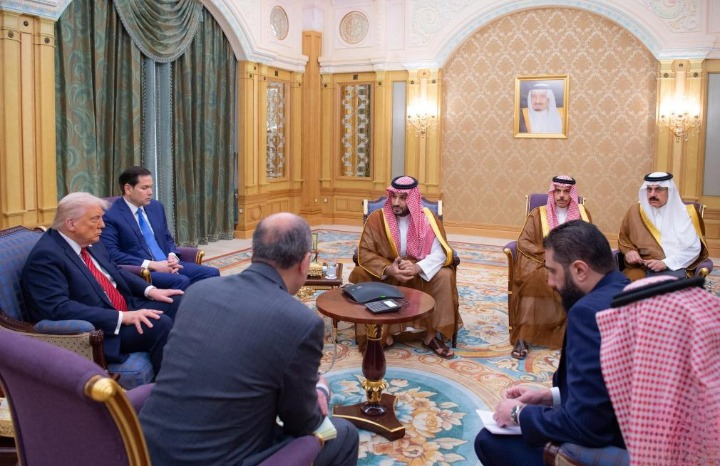
- The U.S. and Saudi Arabia agreed to a major economic partnership, including U.S. support for Saudi access to AI chips and a $142 billion Saudi purchase of U.S. goods, their largest bilateral trade deal to date.
- President Trump aims to include Saudi Arabia in the Abraham Accords, recognising Israel, as part of a broader strategy to align Turkey, Saudi Arabia, and Israel against the China-Russia-Iran axis.
- The new Syrian leader, who once headed HTS, a group previously designated as a terrorist organisation and backed by Türkiye, is now being welcomed by Western countries, which clearly shows that Western nations prioritise strategic interests over consistent principles.
- While India maintains strong ties with Saudi Arabia and the UAE and is exploring economic opportunities amid regional diversification, Türkiye’s rising influence poses a challenge.
President Trump went to Saudi Arabia on his first foreign trip after returning to office. The visit was historic because of the many important dealings that took place between the two countries. PM Bin Salman himself went to personally welcome President Trump. President Trump, while addressing PM Bin Salman, said that he has a lot of respect for Saudi Arabia and the relationship between the two countries is very good. One of the major outcomes was the decision that Saudi Arabia would invest $600 billion in the United States of America. In addition, both the United States and Saudi Arabia agreed to a special economic partnership, under which the United States would help facilitate Saudi Arabia’s access to AI chips. Saudi Arabia also agreed to purchase $142 billion worth of goods and services from the United States. This marks the biggest bilateral trade deal between Saudi Arabia and the United States.
It is important to note that an American-Saudi Arabian Business Forum was also organised in Riyadh. President Trump’s delegation not only included cabinet members but also 20 prominent business tycoons from the United States, including OpenAI CEO Sam Altman and BlackRock CEO Larry Fink. It was also decided that Saudi Arabia would allow Starlink access across its territory.
This is considered one of the most successful visits in recent times between the two countries. The visit carried not only economic significance through the deals and bilateral agreements signed but also strong diplomatic messaging. Saudi Arabia has become one of the most prominent territories for the United States. The country, traditionally oil-dependent, is undergoing economic transformation, and the United States wants to capitalise on this opportunity.
The United States’ relations with Saudi Arabia are not only important for its regional presence in West Asia but also vital to counter the influence of China in the region. President Trump made it clear that he would like Saudi Arabia to become a party to the Abraham Accords, under which Saudi Arabia would recognise Israel. The American understanding in West Asia is to create a nexus involving Turkey, Saudi Arabia, and Israel to ensure a strong American presence in the region. This alignment would be used strategically against the Chinese, Russian, and Iranian axis.
This visit was also historic because, for the first time in 25 years, President Trump met with the de facto head of state of Syria. Last year, in December, Syria witnessed a political change where the Iranian-Russian-backed leader Bashar al-Assad, was removed. The Turkish-American-Israeli-backed group HTS, led by Al-Sharra, gained legitimacy. During the Saudi-American Business Forum, President Trump made a historic announcement that all U.S. sanctions against Syria would be removed. This was followed by a trilateral meeting between President Trump, Saudi Crown Prince Mohammed bin Salman, and the new Syrian head, which was later joined virtually by Turkish President Erdogan.
This indicates a clear understanding between Saudi Arabia, Türkiye, and the United States regarding Syria. The current Syrian leader is supported by all three parties, who have a common interest in Syria. It is interesting to observe how things have changed—under the former Syrian president, Syria was a pariah state, heavily sanctioned, with no diplomatic engagement with Europe or the United States. However, under the new leadership, the Syrian head has met with French President Macron, Italian Prime Minister Meloni, and now U.S. President Trump.
This same leader, who heads HTS, once designated as a terrorist entity backed by Türkiye, is now being engaged by Western countries. This reveals that Western nations are less concerned about who rules Syria and more focused on how Syria can serve their strategic interests. This is a reflection of the opportunism and hypocrisy of Western leadership.
While this visit was ongoing, it was reported that President Trump would also visit Qatar, but not with Israeli officials. This is significant because recent reports suggest growing tensions between President Trump and Israel. The tension arises mainly due to the closer ties between Türkiye, Saudi Arabia, and the United States. Although Israel and the United States have a shared understanding over Syria, Israel is concerned about the growing proximity of Türkiye and Saudi Arabia to the United States. One of Israel’s key concerns is that the United States is considering selling F-35 jets to Türkiye, which, according to Prime Minister Netanyahu, may undermine Israel’s air superiority in the region.
Israel is also worried about President Trump’s diplomatic approach toward Iran, especially the possibility of a new nuclear deal. Israel had hoped for a military offensive against Iran, but now sees the Trump administration favouring diplomacy. Additional tensions emerged from recent statements exchanged between Israel and the United States. Prime Minister Netanyahu suggested that Israel should reduce its dependency on the United States, while American officials believe that President Trump is being manipulated by Netanyahu.
India must now strategise to safeguard its presence in West Asia.
Israel also opposes the U.S. decision to lift sanctions on Syria, fearing that it would give Türkiye a free hand in Syria, which could later challenge Israeli strategic interests. Türkiye has already severed diplomatic ties with Israel over its support for Palestine, which further justifies Israeli concerns.
The ramifications of this visit also affect China. The United States aims to capitalise on economic opportunities in West Asia, particularly in Saudi Arabia and the UAE, as both nations seek to diversify their economies. The United States wants to be a key player in facilitating this diversification, which directly counters China’s regional interests. A strategic understanding between Türkiye, Saudi Arabia, and the United States would only strengthen American influence in West Asia—something that Iran, China, and Russia want to prevent.
For India, this development may not have as significant an impact as it does for China. However, India must now strategise to maintain its presence in West Asia. India already enjoys strong diplomatic ties with Saudi Arabia and good relations with the UAE. India is also trying to explore economic opportunities in the region’s diversification efforts. The challenge for India may arise from Türkiye’s growing presence in the region, especially given its strong support for Pakistan and strained relations with India. This could potentially diminish India’s influence in West Asia.
Aayush Pal is a freelance writer on contemporary geopolitical developments. The views expressed in his work are entirely his own.
